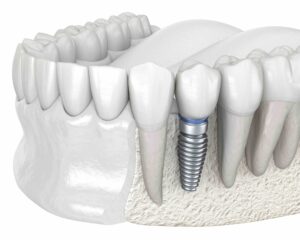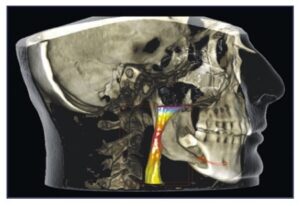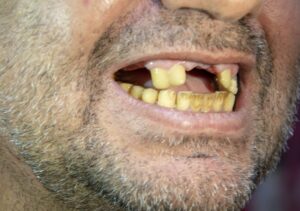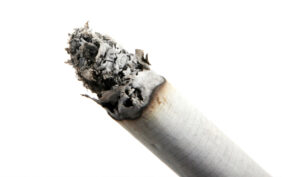Header logo
header top contact widget
Dental Technology
Why You’re Losing Teeth (and how to halt the process)
Posted on Jul 29, 2021 by William J. Claiborne, DDS MS
The inevitable. Murphy’s law. Sooner or later.
It is to no surprise that life throws us occasional curves, some being out of the blue and others being somewhat predictable. As an Asheville Periodontal Specialist, one that comes to mind is the path to losing teeth.
Losing natural teeth is a challenge to both oral and overall health. And, there’s nothing that will definitively replace natural teeth once they’re extracted (although dental implants come pretty close!). Keeping natural teeth and gums healthy is the best way to support your health as you age.
According to a 2017 article published by Dentistry Today that shared recent study findings:
“people who had lost 5 or more teeth by the age of 65 years were more likely to suffer from cardiovascular disease, diabetes, and osteoporosis, all of which could severely limit life expectancy. Many of these illnesses previously have been linked to a person’s quality of life and socioeconomic status. The study concludes that the number of teeth in aging humans can affect longevity and life expectancy.”
https://www.dentistrytoday.com/news/industrynews/item/1632-life-expectancy-linked-to-number-of-teeth
Of course, no one wants to lose a natural tooth. Yet, many people assume that tooth loss is simply a natural part of the aging process. It’s not.
Through the years, certainly, accidents, injuries, decay, gum disease and deep fractures in teeth can result in loss of teeth. Regardless of how committed some people are to their oral hygiene regimen at home and regular dental check-ups, unexpected occurrences can lead to the need for an extraction.
However, the people who are committed to their oral health are far less likely to endure the undesirable outcome of tooth removal. The measures are simple and take very little time.
• Brush your teeth at least twice a day, for a minimum of two minutes each time.
• Floss daily.
• Avoid snacking and limit sugar.
• Drink plenty of water.
• See your dentist twice a year for exams and cleanings.
• Don’t smoke.
Although smoking cessation is a tough task for most people, the other items listed above require just minutes a day and cost very little. What they help you accomplish is PREVENTION. Rather than have problems treated, many instances surrounding tooth loss could have been prevented.
It is far less costly and time consuming to be attentive to your oral health than deal with the repercussions of insufficient oral upkeep. Losing a tooth will require a lifelong commitment, regardless of how it is replaced. And, replacing teeth is absolutely necessary.
When a tooth is lost, whether it can be seen in a smile or not, it no longer supports the surrounding teeth. The tooth above (or below) can elongate. Neighboring teeth can tilt or turn since they lack the bolstering affect provided by the now-missing tooth.
These factors can lead to chipped, fractured or broken teeth. They can also be an issue in bite misalignment. A misaligned bite can cause stress or strain on the temporomandibular joints (TMJ). The results can be frequent headaches, sore jaw joints, ear ringing, dizziness, and difficulty opening the mouth fully.
Another problem lies in the absence of the missing tooth’s roots. When these roots are missing, there is a lack of stimulation and nourishment to the jaw bone in this area. Without this, the bone begins to shrink, or resorb. Bone mass decline affects the stability of the adjacent teeth. It is known that the next tooth to be lost will most likely be one bordering a missing one.
The path to tooth loss, other than accident or injury, is actually a pretty predictable one. For people who take their oral hygiene lightly, it’s not a matter of “if” but “when”. Bacteria buildup in the mouth should be removed regularly, which is why twice-daily brushing is advised. If not thoroughly removed, their growth runs rampant.
Saliva flow helps in moving some bacteria out of the oral cavity. However, as people age, saliva flow decreases. Add to that the many elements that are drying to oral tissues: caffeine (including coffee, tea and colas), many medications, snoring, and some health conditions.
Oral bacteria that accumulate in the mouth for more than 48 hours first create a sticky film that coats the teeth and gums. This is plaque. If not removed through brushing and flossing, plaque transforms into hardened masses on the base of (or between) some teeth. This is tartar, which can no longer be brushed or flossed away.
As tartar spreads, the gums become inflamed. This causes gingivitis – the first stage of gum disease. Gingivitis causes the gums to become tender, swell, and sometimes bleed when brushing. Breath odor can become frequently bad.
If not resolved quickly, gingivitis can progress into full-blown gum disease. At this stage, the gums are red, inflamed, tender, bleed easily and breath odor is bad, even shortly after brushing.
As gum disease worsens, gums loosen their strong seal around the base of teeth. This allows entry of these infectious bacteria below the gum line. The structures that support natural teeth (including bone) are attacked, which can cause some teeth to loosen.
The advanced stage of gum disease is periodontitis. This means that gum tissues are red, spongy, have pockets of pus, bleed even when eating, and breath odor is putrid. To add insult to injury, this devastation doesn’t remain only in the mouth. Through tears in diseased gum tissues, the inflammatory bacteria of gum disease can enter the bloodstream.
This bacteria has been linked to serious, even life-threatening, health problems, as severe as stroke, heart disease, some cancers and Alzheimer’s disease. It can cause inflammatory triggers that worsen diabetes and prostatitis and cause preterm births.
Obviously, it’s important to keep your teeth and gums healthy. And, if tooth loss does occur, consider replacing it/them with dental implants. As an Asheville periodontist, one of my areas of advanced skill is in dental implant diagnosis and placement.
Dental implants are the closest thing to the look, feel and function of natural teeth. They restore dependable biting and chewing, without the need to be removed for cleaning. Best of all, confidence in smiling and laughing returns.
We frequently see Western NC adults who feared they would lose teeth due to periodontal disease and/or had already lost one or more natural teeth. Through our advanced skills and computerized technology, we are often able to fully restore people to excellent oral health and halt the progression of tooth loss.
If you have avoided seeing a dentist because of fear or anxiety, please know that we provide our patients with an environment of respect and comfort. We offer I.V. sedation (‘twilight sleep’) as well as oral sedation to create a totally relaxed state throughout treatment.
If cost is a concern, we also have payment plans that can help you achieve the smile you desire while making monthly payments that fit your budget.
Why allow tooth loss to happen? It CAN and SHOULD be prevented and we can help you regardless of your current oral condition. Call 828-274-9440 to request a consultation appointment. This will take place in a private consultation room where your questions will be answered thoroughly.
Keep The Mouth Moist To Minimize Bacterial Growth
Posted on Jul 22, 2021 by William J. Claiborne, DDS MS
When you think of an environment of a warm, dark, moist space, it would seem to be a perfect breeding ground for bacteria growth. For homeowners, the worry over this is often how easily mold forms in such places.
According to FEMA (Federal Emergency Management Agency), molds are microscopic organisms that thrive anywhere there is a moist environment. Growth can start on a damp surface within 24 to 48 hours.
Molds digest organic material, eventually destroying the material they grow on, and then spread to destroy adjacent organic material. (https://www.fema.gov/pdf/rebuild/recover/fema_mold_brochure_english.pdf)
As an Asheville periodontist, I can’t help but think of the similarities to the mouth. Bacteria in the mouth, when not removed, can multiply and form the sticky film that coats teeth and gums. This is known as plaque.
Like molds, plaque must to be removed to prevent its spread and destructive nature. This is what your twice-daily brushing and flossing regimen is intended to do. When plaque remains in the mouth for roughly 48 hours, it hardens onto teeth. This is tartar and typically forms between teeth or in chunks at the base of teeth.
Essentially, tartar is a hardened mass of bacteria. Like mold, tartar continues to grow if not removed. And, like mold, tartar can cause damage to what it is growing on and spread to surrounding structures.
In addition to a brushing and flossing routine, the mouth has a particular advantage in its ability to control bacteria growth. Saliva is a continual rinsing agent that moves bacteria out of the mouth before the reproductive ability begins or accumulation runs rampant.
However, a dry mouth, which can be the result of a number of factors, means saliva is operating at quite a disadvantage to oral health.
Oral dryness is a natural part of the aging process. It affects about one in five older adults. A dry mouth can also occur from:
• As a side effect of many medications (including prescription and OTC)
• Radiation therapy, especially for head and neck cancer
• Mouth-breathing, which may be due to nasal congestion or snoring
• Medical conditions, such as diabetes, Alzheimer’s disease, stroke and Sjogren’s syndrome
Mold has an odor. So does oral dryness, which reveals itself through bad breath.
Just as mold can destroy things like drywall, carpets and insulation, an overload of bacteria in the mouth can be destructive to teeth and gums. These living and breeding organisms thrive on gum tissues. 
Although saliva is an aid in bacteria control, there is a limit to what the flow is able to manage. When oral bacteria reach a certain level, they cause inflammation in oral tissues. The early stage of this, known as gingivitis, causes the gum to become tender and swollen. When brushing, blood may be present in the sink when rinsing.
Gingivitis, at this stage, can be contained and resolved if quickly addressed. If not, the bacteria will continue to multiply. This creates inflammation in the gums. This means the inflammation has progressed to periodontal disease, which requires treatment since it is now below the gum line.
Beneath the gum line, the bacteria continue their attack on the structures that support natural teeth. This includes the bone structures surrounding tooth roots. At this point, the gums bleed easily and breath odor is persistently bad. The gums become red and swollen and may pull away from the base of some teeth (gum recession).
Resolving gum disease at this point requires a procedure known as scaling & root planing. This allows the dental professional to reach below the gum’s surface to remove the bacteria. More extensive than a dental cleaning, the gum tissues are numbed and the process may require more than one visit to complete.
If the disease is not treated, it will reach the stage of periodontitis. This is an advanced stage of gum disease that is highly infectious and destructive. Because it leaves the gum tissues in such a weakened state, the infection can easily penetrate beyond the gums and enter the bloodstream.
Symptoms of periodontitis are very uncomfortable. Gums turn spongy and breath odor is putrid. Pus pockets appear on the gums and it may become painful to eat. Some teeth may loosen and eventually need removal.
This is where the damage of periodontal disease bacteria becomes even more destructive. As bad as tooth loss is, hold onto your hat…
Because these bacteria can trigger inflammatory reactions elsewhere in the body, researchers have linked them to a wide range of serious health problems.
The bacteria of gum disease have been correlated to heart disease, stroke, some cancers, diabetes, arthritis, and preterm babies. This is rather telling as to the potency of this harmful bacteria and the destructive nature.
When mold in a house that began in one spot is ignored, the destruction spreads. That’s a pretty good reason to tend to the problem before it gets out of hand, right? Proper care for oral health is worth the minor investment of time and money to avoid the destruction that can occur, including keeping the mouth moist to support sufficient saliva flow.
Here are a few pointers to help you maintain oral moisture:
• Keep the mouth moist by drinking plenty of water throughout the day. Watch your limit of caffeine, including coffee, tea and colas.
• If you take medications that have a side effect of oral dryness, ask your doctor about options that may be less drying to the mouth. Or, increase your water intake and use a daily rinse to replenish oral moisture.
• If you snore or breath through your mouth during sleep, talk to your doctor about ways to resolve these problems. It may be as easy as adjusting your sleeping position or adding a side pillow. Or, an oral appliance may be advised.
• When medical conditions (acid reflux, sinus infections, diabetes, bronchitis) contribute to a dry mouth, be especially committed to your oral hygiene routine at home (brushing and flossing) and up your water intake.
• Know that alcohol (including beer and wine) are drying to oral tissues. Try to swish with water between drinks or have a glass of water nearby to periodically dilute the drying impact.
• Smoking (cigarettes, cigars, vaping) delivers toxic chemicals into the mouth, with the gums taking the first brunt. Be aware of this added risk to the drying effects and take added measures to keep your mouth clean and moist.
I hope you never need the specialty care of a periodontist. However, should you find yourself in need of our care, we place a priority on comfort and ensure a respectful, compassionate approach to each individual.
In our Asheville periodontal office, we provide sedation (“twilight sleep”) for patients during many procedures, if desired. Our office also features some of the most advanced technology available in dentistry, including cone beam imaging, laser dentistry, and computerized guidance for dental implants and other procedures.
Begin with a consultation appointment by calling (828) 274-9440. New patients are always welcome and a referral is not always needed.
Why Seek A Periodontist For Dental Implants
Posted on Jul 13, 2021 by William J. Claiborne, DDS MS
Like many people, I value my relationship with my Internist. Through his care, I am confident that he understands my specific needs to oversee all aspects of my health.
Some of this care occasionally involves being referred to a specialist. For example, my Internist may advise me to see a dermatologist for a particular skin condition. Together, my internist and the dermatologist are able to work in unison so I’m receiving the proper treatment plan according to my particular needs.
I am also a specialist in the dental field. I am a periodontist, which is a specialist who receives most patients through referrals by a general dentist or another dental specialist. This is because a periodontist offers a unique set of skills as well as an advanced level of understanding when it comes to oral tissues and dental implants.
The American Academy of Periodontology defines a Periodontist as: “A periodontist is a dentist who specializes in the prevention, diagnosis, and treatment of periodontal disease, and in the placement of dental implants. Periodontists are also experts in the treatment of oral inflammation. Periodontists receive extensive training in these areas, including three additional years of education beyond dental school. They are familiar with the latest techniques for diagnosing and treating periodontal disease, and are also trained in performing cosmetic periodontal procedures.”
(https://www.perio.org/consumer/what-is-a-periodontist)
To reach this specialty requires an individual to be highly committed. A periodontist begins education by completing 4 years of college (undergraduate training) and then continues another 4 years in dental school to earn a doctorate. To specialize in Periodontics, he or she must further their education for another 3-4 years before completing the stringent requirements for a specialty certification in periodontics.
In addition to treating all phases of periodontal (gum) disease, a periodontal specialist is uniquely qualified to reshape gum tissues. This may be performed to correct a “gummy smile” or even out a smile line through crown lengthening. Periodontists also specialize in the diagnosis and placement of dental implants.
The advantages of a periodontist in dental implant treatment are multi-faceted. This specialist is trained to understand the intricate concepts involved in selecting the proper type of implant and skilled at placing implants at proper depths and angles. A periodontist is also able to optimize patient comfort during treatment and throughout the healing phase.
Using his or her advanced training in the diagnosis and placement of dental implants, a periodontist can help you enjoy a higher potential for dental implant treatment that lasts a lifetime. There are a number of reasons you should strongly consider having a periodontal specialist involved in dental implant treatment, including:
SELECTION OF IMPLANTS – Dental implants come in a wide array of shapes and sizes. Each system is designed to accommodate certain needs and preferences. For example, some implants are designed to support a full arch of teeth while others can be placed in areas where a great deal of bone loss has occurred. The selection of the implant type that is appropriate for your needs and goals requires a unique understanding of all implant types. That is, a periodontist can select the type that will work best for you rather than go with the one or two in which they have received training.
PLACEMENT OF IMPLANTS – In addition to selecting the best type for your needs, proper placement of implants has a great deal to do with having a successful outcome. When an implant that is too long, for instance, is placed in bone that is too shallow, it can have future repercussions that may require its removal. This could occur when a lower implant is placed too close to a nerve that runs horizontal through the jaw bone (mandible). Or, when an upper implant is placed in shallow bone, it can work its way into the sinus cavity. A periodontal specialist considers intricate factors that can effect your potential for success.
STRUCTURAL ISSUES – In addition to the factors involved with bone loss, other issues can ‘make or break’ having a successful treatment outcome with dental implants. For example, for people who have bite misalignment or TMJ disorders, they may be grinding or clenching their teeth during sleep – often unknowingly. Telltale signs of ‘bruxing’ including remaining, natural teeth that are chipped or worn. These forces are enough to crack a walnut. When dental implants endure these forces, especially during their ‘healing’ phase, there is greater risk for implant failure. A periodontist considers these issues prior to your treatment, helping you to bypass problems that can result in eventual removal.
INDIVIDUALIZED TREATMENT CONSIDERATIONS – Our goal is to help you get the most from your dental implants. When there are individual habits or preferences that can complicate success, we work with each patient to help them enjoy their dental implants for a lifetime. For smokers, we advise ways to support saliva flow and minimize oral bacteria levels. For people who take certain medications that can interfere with oral moisture, we recommend methods to keep the mouth properly hydrated. And so on. We want to make sure your care is individualized so your potential for implant success is high!
OPTIMAL COMFORT – For added comfort and relaxation, we offer Oral sedation or I.V. sedation (twilight sleep) for most procedures for those who want or need these options. Both sedations are administered to the highest standards of safety possible. Our sedated patients are closely monitored throughout treatment with advanced safety equipment and trained professionals. Oral sedation is a pill that helps patients relax. It also has an amnesiac effect, leaving most with little or no memory of treatment afterward. I.V. sedation places the patient in a deeper sedative state, also erasing memory of the procedure. At our Asheville office, Biltmore Periodontics administers sedation with the involvement of a highly-trained doctor of anesthesiology for optimal comfort and safety.
For individuals who wish to replace one or more missing teeth, it makes sense that dental implants have become the leading preference. Dental implants restore the look, feel, and function like that of natural teeth. They also help to prevent bone shrinkage that occurs when tooth roots are no longer present in the jaw bone. This process is known as resorption.
Resorption is what contributes to changes in facial appearance when the bone structures that give the face its shape start to shrink. When tooth roots no longer exist in the jaw bone, the stimulation once provided to the bone no longer exists. This causes the bone to shrink, or ‘resorb.’
As the bone mass declines in height and thins out, changes in facial appearance slowly evolve. For example, as the jaw bone thins, deep wrinkles form around the mouth. Eventually, the corners of the mouth will turn down even in a smile. Jowls form on each side of the face as facial muscles detach from the shrinking bone structure.
As the jaw bone continues to shrink, the chin becomes more pointed and the nose seems to get closer to it. This leads to a collapsed mouth that is known as a ‘granny look.’ This look ages the appearance of an individual far beyond their actual years.
Among the many benefits of dental implants, they also provide stimulation to the jaw bone. This helps to halt the process of bone loss. For those who have already lost a great deal of bone, bone rebuilding procedures can be performed to restore a healthy, more youthful face shape.
In addition to all the advantages of care through a periodontist, our Asheville periodontal office features some of the most advanced technology available. This includes laser dentistry and cone beam imaging as well as highly-advanced computerized options.
If you’ve considered dental implants to replace missing teeth, we invite you to consult with us during a private consultation appointment. A referral is not necessary. During this time, we will discuss your needs and goals as well as any concerns regarding comfort or costs.
To schedule, call (828) 274-9440.
Don’t Smoke? Living Or Working With A Smoker Creates Higher Risks Than Once Thought.
Posted on May 14, 2021 by William J. Claiborne, DDS MS
I doubt there is anyone in the U.S. who smokes tobacco who is unaware of the fact that it’s an unhealthy habit. Although the heart and lungs are more widely associated with the health risks of smoking, many people miss the fact that it is also damaging to the tissues in the mouth.
Consider the devastating statistics of COVID-19 related deaths in the U.S., nearing the 600,000 mark. Yet, when it comes to your oral health, cigarette smoking is responsible for more than 480,000 deaths per year in the United States. For people who don’t smoke but live or work with a smoker, secondhand smoke exposure accounts for over 41,000 of these.
For nonsmokers who are victims of secondhand smoke, that’s a tough statistic to accept.
Just how harmful is secondhand smoke? British researchers recently released some interesting findings along these lines. Their studies included several major countries and tracked nearly 7,000 adults, with nearly half being exposed to secondhand smoke. The findings showed that breathing in the smoke of another person’s cigarette can increase the risk of oral cancer by more than 50 percent. These cancers include lip, mouth and throat cancers.
On average, smokers die 10 years earlier than nonsmokers. For every person who dies because of smoking, at least 30 people live with a serious illness related to smoking. Smoking leads to disease and disability and harms nearly every organ of the body.
When considering the mouth, smoking can create costly problems in addition to a higher risk of tooth loss.
Twenty years of research shows that cigarette smoking is a risk factor for periodontitis. A smoker is 2 – 3 times as likely to develop periodontitis, which is an advanced stage of gum disease. In addition to increased prevalence, smokers also experience greater severity of gum disease.
Nicotine (in any form) has been shown to reduce blood flow in the gum tissues in the mouth. Pipe smoking can be worse than cigarettes due to the higher temperatures generated in the upper jaw. When it comes to dental implants, smoking is a risk factor for failure. It is also detrimental for conventional bridgework.
Cigarette smoking has long been associated with serious oral conditions, including periodontal (gum) disease, bone loss, tissue loss, and tooth loss. For smokers who opt for dental implants to replace missing teeth, they have a higher risk of peri-implantitis, which is inflammation of the soft and hard gum tissues surrounding a dental implant. To no surprise, smokers have a higher incidence of dental implant failure.
In an article published by the Journal of International’s Society of Preventive & Community Dentistry as far back as 2012, it warned that smoking can impact the rate of dental implant success, accounting for up to 20 percent of failures.
“Clinical trials of endosseous implants consistently rate smoking as a primary patient-centered risk factor for implant loss.”
https://www.ncbi.nlm.nih.gov/pmc/articles/PMC3894084/
It is common knowledge that the nicotine in cigarettes, e-cigs and ‘chew’ is an addictive drug. Some concerning quotes shared by the Oral Cancer Foundation are:
“Scientists have found that nicotine is as addictive as heroin, cocaine or amphetamines, and for most people, more addictive than alcohol,” states the article “Nicotine, Harder to Kick than Heroin,” published in the New York Times Magazine.
“Nicotine is similar in all critical measures to prototypic drugs of abuse such as cocaine, morphine and heroin.”
“Nicotine is a poison used as an insecticide.”
https://oralcancerfoundation.org/understanding/tobacco/tobacco-and-addiction/
Now, knowing the effects of secondhand smoke are likened to the non-smoking “victim” as inhaling half as many cigarettes as the user they live or work with, smokers should consider their habit in a different light.
While our Asheville periodontal dental office does not lecture or “guilt” our patients in any way, we feel they deserve to know the hazards of any risk factor related to the well being of their oral health. Without a doubt, smoking (whether cigarettes or vaping) is harmful to oral tissues and the potential to keep natural teeth.
In a report shared by Delta Dental, smokers are about twice as likely to lose their teeth than non-smokers, according to two 30-year studies at Tufts University in Boston. Their findings showed that men who smoke lose about 3 teeth for every 10 years of smoking, with women losing an average of 1.5 teeth per decade.
https://www.deltadentalins.com/oral_health/teethinpack.html
Every year, about half of smokers make some attempt at kicking the habit. Yet, only 6 or so percent are fully successful. All the while, the tobacco industry spends BILLIONS of dollars each year on cigarette and smokeless tobacco advertising and promotions.
According to the Centers for Disease Control & Prevention (CDC), in 2018 “$9.06 billion was spent on advertising and promotion of cigarettes and smokeless tobacco combined—about $25 million every day.” That’s more than $1 million dollars spent every hour of every day.
https://www.cdc.gov/tobacco/data_statistics/fact_sheets/economics/econ_facts/index.htm
While nicotine addiction means big money to the tobacco industry, it is enormously costly to our population. Now, knowing that secondhand smoke is so harmful to others, I hope our smoker patients will welcome our respectful support in their efforts to quit as we help them to maintain good oral health and keep their teeth (or dental implants) healthy for a lifetime of confident smiles.
If you’ve considered dental implants to replace missing teeth and smoke, please consult with us to discuss ways we can help you minimize the potential for dental implant failure. We want you to reap the benefits of a smile you’ll want to share proudly.
Call 828-274-9440 to schedule.
Recent Posts
Categories
Archives
- September 2024
- August 2024
- July 2024
- June 2024
- May 2024
- April 2024
- March 2024
- February 2024
- January 2024
- December 2023
- November 2023
- October 2023
- September 2023
- August 2023
- July 2023
- June 2023
- May 2023
- April 2023
- March 2023
- February 2023
- January 2023
- December 2022
- November 2022
- October 2022
- September 2022
- August 2022
- July 2022
- June 2022
- May 2022
- April 2022
- March 2022
- February 2022
- January 2022
- December 2021
- November 2021
- October 2021
- September 2021
- August 2021
- July 2021
- June 2021
- May 2021
- April 2021
- March 2021
- February 2021
- January 2021
- December 2020
- November 2020
- October 2020
- September 2020
- August 2020
- July 2020
- June 2020
- May 2020
- April 2020
- March 2020
- February 2020
- January 2020
- December 2019
- November 2019
- October 2019
- September 2019
- August 2019
- July 2019
- June 2019
- May 2019
- April 2019
- March 2019
- February 2019
- January 2019
- December 2018
- November 2018
- October 2018
- September 2018
- August 2018
- July 2018
- June 2018
- May 2018
- April 2018
- March 2018
- February 2018
- January 2018
- December 2017
- November 2017
- October 2017
- September 2017
- August 2017
- July 2017
- June 2017
- May 2017
- April 2017
- March 2017
- February 2017
- January 2017
- December 2016
- November 2016
- October 2016
- September 2016
- August 2016
- July 2016
- June 2016
- May 2016
- April 2016
- March 2016
- February 2016
- January 2016
- December 2015
- November 2015
- October 2015
- September 2015
- August 2015
- July 2015
- June 2015
- May 2015
- April 2015
- March 2015
- February 2015
- January 2015
- December 2014
- November 2014
- October 2014
- September 2014
- August 2014
- July 2014
- June 2014
- May 2014
- April 2014
- March 2014
- February 2014
- January 2014
- December 2013
- November 2013
- October 2013
- September 2013
- August 2013
- July 2013
- June 2013
- May 2013
- April 2013
- March 2013
- February 2013
- January 2013
- December 2012
- November 2012
- October 2012
- September 2012
- August 2012
- July 2012
- June 2012


